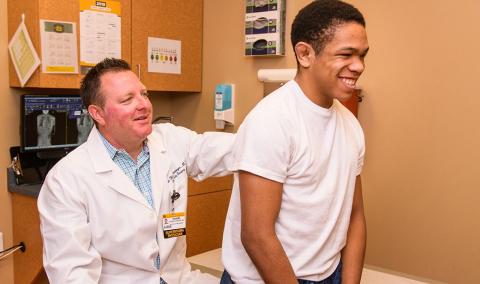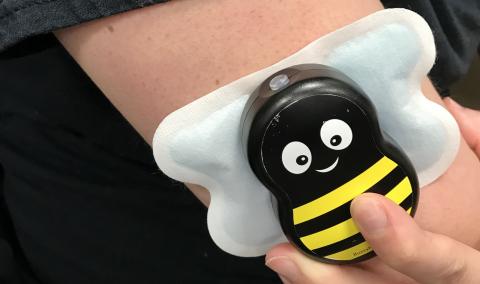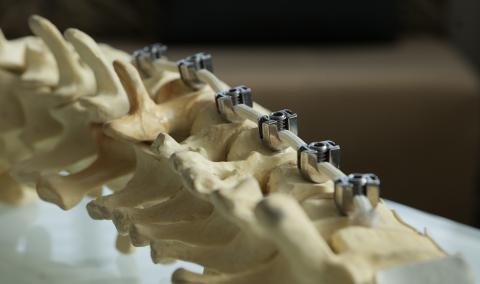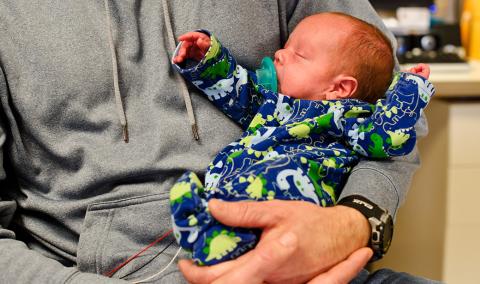Spondyloepiphyseal dysplasia congenita (SEDC) is a rare genetic disorder characterized by deformities that begin before birth, including skeletal and joint malformations involving the spine, hips and knees and abnormalities affecting the eyes. About one in 100,000 newborns are affected. Spondyloepiphyseal dysplasia tarda (SEDT) affects only males, and its symptoms often are not apparent until a child is 6 to 8 years old.
If you have a child with spondyloepiphyseal dysplasia, you want him or her to receive comprehensive care from a team of experts. At University of Missouri Health Care, we are the region's experts in treating skeletal dysplasia diseases. We are actively involved with national research for treatments, and the leader of our team, Daniel Hoernschemeyer, MD, sits on the medical advisory board of the Little People of America so he can be actively involved with the issues affecting the health of skeletal dysplasia patients.
Spondyloepiphyseal dysplasia CHARACTERISTICS
Growth deformities lead to SEDC patients being shorter than normal, with average adult heights ranging from 3 feet to just over 4 feet. Their hands and feet are usually of average size, though. Some patients may develop hearing and vision problems. Intelligence is unaffected. SEDC is characterized by distinctive skeletal malformations affecting the long bones of the arms and legs as well as the bones of the spine.
SEDT patients range in height from 4-foot-10 to 5-6, with a disproportionately short trunk and barrel chest. Hands, head and feet are normal size.
Spondyloepiphyseal dysplasia DIAGNOSIS AND TREATMENT
SEDC's skeletal features are present at birth and evolve over time. SEDT is not apparent until a child is 6 to 8 years old, when spinal growth declines and stops while limb growth continues. Genetic testing can confirm a clinical diagnosis.
Limb-lengthening surgery should only be discussed when the patient is old enough to weigh the risks and benefits. Adaptability products can help people do daily tasks such as hygiene, driving and reaching household items.
RESOURCES FOR FAMILIES
Click here for more resources and additional details about spondyloepiphyseal dysplasia.
Related Conditions & Treatments
- Adolescent Medicine
- Chest Wall Deformities
- Down Syndrome
- Emergency Care for Kids
- Gastrostomy and Feeding Access Program
- Hyperbaric Oxygen Therapy
- Juvenile Diabetes
- Neonatology
- Pediatric Anesthesiology
- Pediatric Cancer
- Pectus Carinatum
- Pectus Excavatum
- Pediatric Cardiology
- Pediatric Dermatology
- Pediatric Development and Behavior
- Pediatric ENT (Ear, Nose and Throat)
- Pediatric Epilepsy
- Pediatric Eye Care
- Pediatric Gastroenterology
- Pediatric Infectious Diseases
- Pediatric Inpatient Rehabilitation
- Pediatric Nephrology
- Pediatric Neurology
- Pediatric Neurosurgery
- Pediatric Orthopaedics
- Pediatric Plastic Surgery
- Pediatric Primary Care
- Pediatric Psychiatry
- Pediatric Pulmonary Medicine
- Pediatric Sleep Medicine
- Pediatric Surgery
- Pediatric Surgical Services
- Pediatric Urology
- Pediatric Vascular Anomalies
- Pediatric Weight Management
- Sickle Cell Disease
- Aerodigestive Program


























